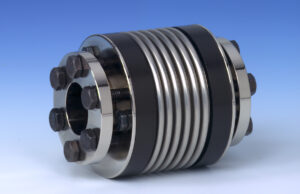By Joyce Laird, contributing editor
Two Categories of Connections
In the world of power transmission and motion control, the different methods of connecting rotating components can be divided into two categories: positive form fit connections, and frictional connections. “Positive form fit connections are the more traditional means, and the technology dates back some centuries,” Andy Lechner, Product Manager, R+W America, says.
 “Most commonly they involve using a square key, which resides in notches cut into both the shaft and the hub. Another slightly more sophisticated positive form fit connection is a spline, where a mating star pattern is used instead of a square key. This allows for increased torque density, as the stress is distributed across a larger number of small teeth rather than being concentrated on a relatively large single key; but they are more expensive to produce.” Recent Connection Developments
“Most commonly they involve using a square key, which resides in notches cut into both the shaft and the hub. Another slightly more sophisticated positive form fit connection is a spline, where a mating star pattern is used instead of a square key. This allows for increased torque density, as the stress is distributed across a larger number of small teeth rather than being concentrated on a relatively large single key; but they are more expensive to produce.” Recent Connection Developments
In more recent decades, mechanical engineers have developed a wide variety of frictional clamping devices, to be used as alternatives to older positive form fit drive connection designs. The advantage of frictional clamping lies in the fact that the shaft and hub are completely locked together in rotation, with no clearance between keys and keyways. “This means that the shaft connections can withstand heavy vibration and alternating loads without wearing out” Lechner explains.
Conical Clamping Hubs
Lechner says that while simple clamping collars are very common for light duty applications, tapered conical clamping connections are preferred for the transmission of higher torques. “There are a number of different configurations, but all of them rely on the same basic principle. When two slightly tapered conical surfaces are wedged against each other by flange screws, the resulting radial pressure generated against the shaft and hub surfaces is sufficient to lock the components together with sufficient strength to transfer large forces without any relative movement.”
“Conical clamping type hubs provide further protection from torque overload and potential shaft slipping in high torque applications where a hard stop or aggressive load reversal takes place. These types of clamping hubs typically are manufactured from steel and tend to generate extremely high clamping pressure relative to normal application requirements. “
“As a result, conical clamping connections have become very popular as a way of reducing maintenance costs in heavy equipment, as well as increasing the level of precision in high speed manufacturing equipment,” he adds.
A New World of Choice for Design Engineers
Other keyless clamping devices include expansion shafts, fully split clamping hubs, as well as some others, each with their own unique purposes. As the field of precision motion control continues to develop faster, smaller, and more accurate systems, mechanical products are required to evolve in order to keep up with demands for acceleration and control that were not possible 50 years ago.
“Performance issues related to backlash, size, inertia, and balance have all lead mechanical component suppliers to adapt to new standards and practices in order to eliminate shaft keys,” Lechner says. “While most keyless hub designs have existed for quite some time, their use in power transmission and motion control has increased widely over the past few years. To learn more about the range of shaft locking devices and finding the right match for a specific application, contacting a knowledgeable supplier is always the best first action to take.”
R+W America
www.rw-america.com
Leave a Reply